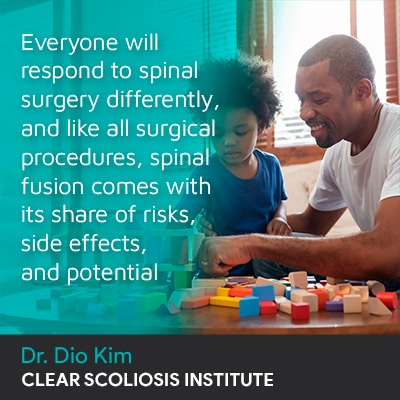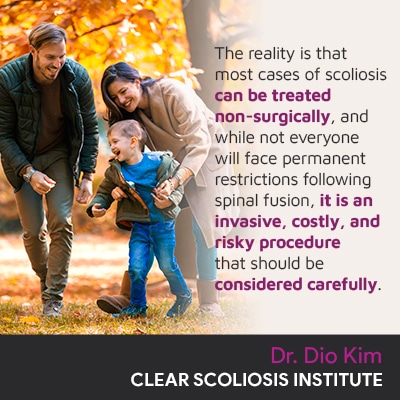
The end goal of spinal fusion is stopping progression, not correction, and this is an important distinction to understand. While not everyone is guaranteed to experience any permanent restrictions following spinal fusion, the risk is there, particularly in terms of spinal flexibility, range of motion and pain, so should be considered carefully.
Spinal fusion surgery is an invasive procedure commonly used in traditional scoliosis treatment. Results will be case-specific and depend on variables such as patient age, condition severity, amount of vertebrae fused, and whether or not there were complications during the procedure.
Before getting to the specific risks associated with spinal fusion surgery, let’s first talk generally about scoliosis.
There are many different spinal conditions people can develop that involve a loss of its healthy curves; scoliosis is highly prevalent with current estimates at close to seven million people living with the condition in the United States alone.
Scoliosis involves the development of an unnatural sideways spinal curve, with rotation, and a minimum Cobb angle measurement of 10 degrees.
It’s the rotational component that makes scoliosis a 3-dimensional condition as in addition to bending unnaturally to the side, the scoliotic spine twists from back to front, front to back.
A patient’s Cobb angle is determined during X-ray and is a measurement that tells me how far out of alignment a scoliotic spine is, in addition to placing conditions on a severity scale:
In addition, scoliosis is progressive, meaning it has it in its very nature to worsen over time, so where a scoliosis is at the time of diagnosis is not indicative of where it will stay; a diagnosis of mild scoliosis can easily progress to moderate and severe, especially if left untreated, or not treated proactively.
So scoliosis introduces a lot of uneven forces to the body, which doesn't just affect the spine, but also its surrounding muscles, ligaments, and nerves.
Although, as a progressive condition, scoliosis is incurable, it is highly treatable, but how a patient chooses to treat it is important because different treatment approaches offer different potential outcomes.
Now that we’ve touched on some important condition characteristics, let’s talk about spinal fusion surgery, including common restrictions.

Often, rods are attached to the spine with screws to hold it in place, and this hardware is permanent.
The theory behind this is that by fusing the most-tilted vertebrae together, it eliminates movement (progression) in the area, and the rods hold the spine in a straighter position.
Everyone will respond to spinal surgery differently, and like all surgical procedures, spinal fusion comes with its share of risks, side effects, and potential complications.
When it comes to permanent restrictions following the procedure, this will depend on a number of variables such as patient age and overall health, condition severity, the number and location of vertebrae fused, and whether or not there were any complications during the procedure.
While each patient will respond to spinal fusion in their own way, there are some common side effects and restrictions associated with the time period immediately following the procedure, as well as being associated with certain permanent long-term restrictions.
Immediately following most surgical procedures, there are certain activity restrictions put in place to help a patient rest, restore, and heal, and spinal fusion is no exception.
Again, while each case is unique, common restrictions put in place in the days and weeks immediately following the surgery can include certain bending and twisting motions, lifting objects, driving, and any sports/activities deemed risky for a newly-fused spine.
Risks associated with the procedure itself can include:
As the brain and spine work in tandem to form the body’s central nervous system (CNS), any surgical procedure performed on the spine will carry a risk of nerve damage.
Although uncommon, if there is a hardware malfunction in the days immediately following the procedure, or the patient has an adverse reaction to the hardware used, the only recourse is more surgery, and facing the associated risks all over again.
When we’re talking about permanent restrictions, we’re talking about the long-term effects of living with a fused spine, and while it isn’t guaranteed patients will experience these types of restrictions and effects, some common side effects can include:
Generally speaking, the more vertebrae fused together, the more likely a patient is to experience some long-term restrictions and effects associated with the procedure.
Perhaps one of the most common permanent restrictions caused by spinal fusion is a loss in spinal flexibility and range of motion; this happens because the fused portion of the spine is completely rigid, and while some patients maintain enough spinal flexibility above and/or below the fusion site to not notice a significant difference, many do.
In addition, a fused spine can be painful as spinal rigidity means relying more on the spine’s surrounding muscles for support, and this can lead to tight, sore, and strained muscles: muscle fatigue and pain.
See more Scoliosis Surgery Side Effects here.
As a fused spine is more vulnerable to injury, this can carry a psychological weight for patients as the fear of trying new things and/or participating in much-loved activities from life before surgery can impact overall quality of life.
So for patients who choose to forgo a surgical recommendation, what are the alternatives to spinal fusion surgery?
While traditional scoliosis treatment commonly funnels patients towards spinal fusion surgery, there is a modern alternative treatment option with proven results: conservative chiropractic-centered treatment.
As a CLEAR-certified scoliosis chiropractor, I believe in the merits of proactive treatment started as close to the time of diagnosis as possible; this is because early detection, when responded to with proactive treatment, can increase chances of treatment success.
Patients on the path of traditional scoliosis treatment are likely to end up being a candidate for spinal fusion because the approach doesn’t have a strategy for treating scoliosis while mild, so its watch-and-wait response can mean allowing a scoliotic curve to progress unimpeded.
I believe in prevention: preventing progression through proactive treatment that strives to preserve as much natural spinal function as possible.
Spinal fusion can rob the spine of a certain level of natural function because it’s held in place artificially, while conservative chiropractic-centered treatment has correction as its end goal.
In the context of scoliosis, corrective results means impacting the condition on a structural level in the form of a curvature reduction and increasing core strength for optimal spinal support.
CLEAR-certified scoliosis chiropractors combine multiple condition-specific treatment disciplines to impact conditions on every level:

Through a variety of in-office therapies that use scoliosis-specific exercises (SSEs) to strengthen the spine and its surrounding muscles, spinal support can be improved, and in addition, certain SSEs are known to activate specific areas of the brain for improved brain-body communication, postural remodeling, and more-natural body positioning.
When patients can benefit from using a scoliosis brace as a component of treatment, which can be particularly effective on growing spines, CLEAR-certified scoliosis chiropractors opt for corrective bracing, like the ScoliBrace, to augment corrective results and complement other forms of treatment.
To facilitate sustainable long-term treatment results, a series of custom-prescribed exercises can help establish a home-rehabilitation program.
The reality is that most cases of scoliosis can be treated non-surgically, and while not everyone will face permanent restrictions following spinal fusion, it is an invasive, costly, and risky procedure that should be considered carefully.
At the CLEAR Scoliosis Institute, we want patients to be aware of all treatment options available, and the benefits and risks associated with each; this is important because how a diagnosis of scoliosis is responded to can have far-reaching effects.
While spinal fusion can be successful at straightening a curved spine and preventing further progression, it can do so at the expense of overall spinal health and function, and this can impact a patient’s quality of life.
Fortunately, a conservative chiropractic-centered treatment approach provides patients with a less-invasive treatment option that prioritizes preserving as much natural spinal function as possible, throughout treatment and beyond.

CLEAR provides a unique and innovative way of understanding scoliosis. Sign up to receive facts and information you won’t find anywhere else.
